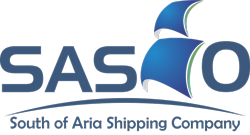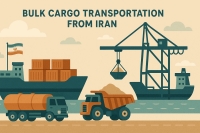What Is Bulk Cargo? Definition and Classification
Bulk cargo refers to large volumes of unpackaged goods that are transported in loose form, usually loaded directly into a ship’s hold, railcar, or truck without individual packaging. Unlike general cargo, which consists of unitized or containerized goods, bulk cargo is handled through specialized equipment such as conveyors, pipelines, or cranes designed for high-capacity loading and unloading.
There are two main categories of bulk cargo: dry bulk and liquid bulk. Dry bulk includes materials like grains, coal, cement, fertilizers, and minerals—commodities often involved in bulk goods transportation from Iran due to the country’s strong mining and agricultural sectors. Liquid bulk, on the other hand, covers petroleum products, chemicals, and petrochemicals, which form a major share of bulk commodity exports through Iranian ports. Together, these categories represent the backbone of large-scale industrial and energy trade worldwide.
Bulk Commodities Commonly Exported from Iran
Iran exports tens of millions of tons of bulk commodities each year, valued at over USD 55 billion in 2024. While crude oil and petrochemical products dominate, mineral, agricultural, and construction materials also play a key role in Iran’s bulk trade. The table below summarizes the major bulk commodities exported from Iran:
|
No. |
Commodity |
Type |
Export Value |
Notes / Main Destinations |
|
1 |
Crude Petroleum |
Liquid |
Largest export; 1.4–1.7 million bpd mainly to China and other Asian buyers. |
|
|
2 |
Petroleum Gases & LNG |
Liquid |
Includes LNG and hydrocarbon gases; key energy export. |
|
|
3 |
Iron Ore |
Dry |
Mined domestically and shipped via southern ports to East Asia. |
|
|
4 |
Ethylene Polymers & Petrochemicals |
Dry / Liquid |
Growing segment; exported as pellets and liquids to Asian markets. |
|
|
5 |
Copper Ore |
Dry |
≈ $463 million |
Includes copper concentrate; part of Iran’s mineral exports. |
|
6 |
Nuts & Dried Fruits |
Dry |
≈ $1.7 billion |
Pistachios, dates, raisins; 45 % of Iran’s agri-food exports, mainly to Russia & neighbors. |
|
7 |
Fertilizers & Chemicals |
Dry |
Derived from petrochemical and mineral industries; regional exports. |
|
|
8 |
Cement, Sulfur & Construction Materials |
Dry |
≈ $785 million |
Exported through southern ports; stable share of non-oil trade. |
Overview of Bulk Cargo Transportation from Iran
In recent years, Iran has reinforced its position in global logistics networks via bulk cargo transportation from Iran, driven by strategic port investments and rising throughput volumes. According to the Ports and Maritime Organization (PMO), the country’s ports handled approximately 234.8 million tons of cargo in the year ending March 2025—of which 74.7 million tons were exported oil-products and 77.9 million tons non-oil goods. ([Tehran Times]) This volume underpins the broader system of Iran bulk export logistics, which facilitate both domestic supply and transit flows.
The route dynamics of bulk freight shipping from Iran are also evolving. Exports increasingly link Iran’s southern maritime gateways to markets in Asia, Africa and Europe via the Persian Gulf and Gulf of Oman. While exact tonnage by commodity is less freely published, transit data show that cargo transit through Iran reached 20.3 million tons in the 11 months to February 2025, a 26 % increase year-on-year. ([Press TV]) This indicates both increased throughput and greater integration with international corridors for transport of bulk goods from Iran beyond pure export bundles.
Nevertheless, constraints persist. International sanctions and financial restrictions continue to impede banking, insurance, and international partnerships for bulk cargo transportation from Iran, leading to higher costs and delays in logistics. Geopolitical tensions, including conflicts in the Strait of Hormuz and regional instability, further exacerbate risks to shipping routes and supply chain reliability.
However, partnering with the best freight forwarder in Iran can effectively mitigate these challenges by providing expert navigation through regulatory hurdles and optimized logistics solutions.
Major Iranian Ports Handling Bulk Cargo Transportation from Iran
Iran’s bulk cargo transportation network relies on several key ports strategically located along the Persian Gulf and the Caspian Sea. These ports form the backbone of the country’s export and transit logistics, linking Iran to major global trade routes.
Persian Gulf Ports
Imam Khomeini Port (Khuzestan Province)
One of Iran’s largest hubs for bulk goods transportation from Iran, handling about 16.5 million tonnes annually. It manages dry bulk such as minerals, ores, and grains, as well as petrochemical bulk commodity exports from Iran. The port offers docking for large bulk carriers and repackaging services, with continuous infrastructure expansion.
Bandar Abbas / Shahid Rajaee Port (Hormozgan Province)
Iran’s busiest commercial complex and the key node in Iran bulk cargo shipping services, processing over 37 million tonnes per year. It includes dedicated terminals for both dry and liquid bulk—such as ore-loading berths and petroleum export wharves—serving as a cornerstone for Iran bulk export logistics ([Marineinsight])
Chabahar Port (Sistan and Baluchestan Province)
Handles around 1.4 million tonnes annually, focusing on transport of bulk goods from Iran to Central Asia. With its new 185-meter mineral berth and projected capacity of 86 million tonnes, it’s becoming a strategic route for bulk cargo transportation from Iran via the Indian Ocean ([Marineinsight])
Bushehr Port (Bushehr Province)
A key gateway for liquid bulk shipments, particularly oil and gas products. It supports bulk freight shipping from Iran within the Persian Gulf region.
Jask Port (Hormozgan Province)
Specializes in oil exports and other liquid bulk commodity exports from Iran, supported by growing facilities for efficient bulk shipment from Iran to Asia and Africa.
Caspian Sea Ports
Amirabad Port (Mazandaran Province)
Handles up to 5 million tonnes per year, integrating Iranian bulk freight logistics with rail and road transport to Central Asia. It includes terminals for dry bulk, oil, and containers, alongside silos and warehouses for bulk goods transportation from Iran ([Marineinsight & jahanta])
Anzali Port (Gilan Province)
Processes around 4 million tonnes annually. Equipped with 11 berths for general and bulk cargo, it supports regional bulk cargo transportation from Iran through the Caspian corridor.
Nowshahr Port (Mazandaran Province)
Manages roughly 1.5 million tonnes yearly, focusing on minerals and construction materials as dry bulk. It’s a growing hub in Iran bulk export logistics, linking northern provinces with Caspian markets.
Collectively, these ports enable Iran to handle more than 53 million tonnes of bulk and general cargo in the first quarter of 2025 alone—underscoring the country’s expanding role in global bulk cargo transportation from Iran and international trade routes.

Key Considerations for Packaging, Loading, and Unloading Bulk Cargo
Ensuring the safe and efficient handling of bulk cargo—whether dry or liquid—is critical to prevent losses and accidents. Key considerations include:
- Moisture control: Maintaining proper humidity levels to prevent spoilage, caking, or liquefaction of dry bulk cargo.
- Flow stability: Ensuring smooth loading and unloading to avoid blockages or uneven settling.
- Appropriate equipment: Using conveyors, cranes, pumps, or pipelines designed for the specific type of bulk material.
- Compliance with safety regulations: Adhering to international and local rules for handling hazardous or high-risk cargo.
- Risk management for liquefaction: For certain dry bulk cargoes, especially minerals, monitoring and preventing liquefaction is essential to ensure vessel stability and safety.
Operational Challenges in Bulk Cargo Transportation from Iran
The sector of bulk cargo transportation from Iran encounters multiple operational hurdles that can affect reliability and cost-efficiency. Port and equipment capacity limitations at major hubs such as Bandar Abbas and Imam Khomeini Port often lead to congestion, slowing the handling of bulk shipment from Iran and reducing throughput efficiency.
Fluctuations in freight rates and insurance costs add another layer of complexity, particularly for operators relying on Iran bulk cargo shipping services to maintain competitive delivery schedules. Additionally, sanctions and banking restrictions continue to constrain international payments, complicating the transport of bulk goods from Iran to global markets.
Finally, geopolitical and security risks along strategic maritime routes, including the Strait of Hormuz, pose challenges to consistent and safe bulk freight shipping from Iran, making risk management and careful route planning essential for the country’s logistics operators.
Effective planning, risk management, and collaboration with the best local marine companies are essential to mitigate delays, optimize routing, and ensure the secure handling of bulk commodities.
Advantages of Partnering with Local Logistics Providers
Partnering with experienced best local NVOCC, such as SASCO, enhances bulk cargo transportation from Iran. Their knowledge of port operations, regional infrastructure, and regulations allows for efficient handling and reduced delays in bulk shipment from Iran. They optimize routing, equipment use, and scheduling across maritime, rail, and road networks, ensuring timely delivery of bulk commodities.
Moreover, collaboration with such providers helps manage operational and geopolitical risks, improving reliability, cost-efficiency, and access to international markets, supporting smooth Iran bulk cargo shipping services and effective bulk goods transportation from Iran.
FAQs
Q1: What factors determine the cost of bulk freight shipping from Iran?
A1: The cost of bulk freight shipping from Iran depends on the commodity type (dry vs liquid bulk), loading and discharge ports, route length, inland transport within Iran, and additional risk premiums due to sanctions or transit delays.
Q2: How is insurance handled for bulk cargo transportation from Iran?
A2: Iran bulk cargo shipping services typically include multi‑modal insurance covering sea, rail and road transits; however, due to Iran’s financial and banking restrictions the premiums and deductibles may be higher compared to standard global terms.
Q3: What are the main destinations for bulk goods transportation from Iran?
A3: Key destinations include Asian markets (especially China), Gulf states (UAE, Oman), and nearby transit corridors into Central Asia, all supported by Iran’s southern and northern port networks.
Q4: How can exporters reduce the cost and risk of bulk shipment from Iran?
A4: Exporters can reduce cost and risk by consolidating shipments, selecting efficient ports (with less congestion), using trusted local service providers, and securing comprehensive insurance tailored to Iran’s export environment.







